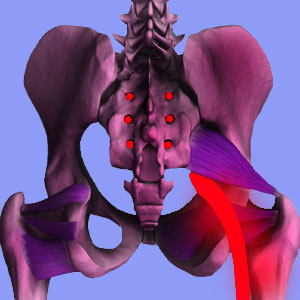
Sciatica from lifting can occur due to spinal injury, cumulative degeneration or other nonspinal causation. Lifting has a bad reputation as an instigator of back pain. Sciatica is well known to be associated with often performed at a job or when working at home. Lifting has been reported as a common onset trigger for many sciatica attacks and flare-ups.
Is lifting inherently bad for the back? Is it a dangerous activity? These are questions that we often receive on our websites and we have already written much on the topic. However, we have yet to address how lifting and sciatica are related, until now.
In this article we will teach you how lifting can cause or contribute to sciatica. However, we will also dispel many of the nocebo-inciting effects of misinformation regarding the pathological aspects of lifting in order to better serve our readership with objective and fact-based, rather than fear-based, information.
Sciatica from Lifting Objects
Listing is a necessary part of life for most people. Traditionally, light lifting is considered any weight that makes up about 10% of less of a person’s body weight. For the average person, this will be between 10 and 25 pounds. This definition does not readily apply itself to morbidly obese people, who might still have to lift over 70 pounds, given this standard definition. Therefore, we limit light lifting to weights of less than 25 pounds, regardless of weight.
Moderate lifting traditionally consists of weights that total 11% to 25% of a person’s body weight, making the average span range from 11 to 63 pounds. Once again, this definition has changed due to the epidemic of obesity, so we tend to limit moderate lifting definition to 63 pounds.
Heavy lifting is defined as weight that exceeds 25% of the body weight, making the normal range spanning 26 to 64 pounds and the lower end and culminating with the maximum any given individual might be able to lift successfully.
All of these definitions are provided simply for the sake of relative comparison. Humans are greatly diverse in their physical abilities. Some people can lift extraordinary amounts of weight, regardless of small body mass, while others might be relative incapable of lifting much weight despite having a larger mass.
Does Heavy Lifting Cause Sciatic Nerve Pain?
When citing lifting as a direct cause or contributor to sciatica, the weight lifted is rarely included in clinical statistics. Simply the act of lifting is provided to be a theorized or known causation/contributor. During our extensive patient interview processes, we have discovered that most patients who report lifting being at least partially to blame for their current sciatica lift light to moderate loads and almost none (fewer than 2%) cite heavy lifting as a contributing activity.
This statistic makes humans seem physically incapable, if lifting such light loads is the actual cause of their pain. The science of it all is really quite illogical. However, we also know many things about sciatica that make all these facts blend perfectly together and make perfect sense. We will discuss more of this in the final section of this report.
Most lifting that seems to create sciatica is performed at home, with a minority occurring in a work environment. We see the most cases involving light workloads that are considered routine activities, such as shoveling snow, transporting groceries, lifting garbage or performing other lifting-related work, like opening a window, raising a garage door or starting a lawn mower. Most patients report lifting with good technique, placing the majority of burden on the legs, rather than the back. Given all this information, lifting seems like a far-fetched cause of symptoms, which is exactly what we have theorized in most circumstances.
Sciatica from Lifting Facts
Lifting can cause or contribute to sciatica. Lifting can cause spinal injury in extreme cases. This injury might take the form of a pathological herniated disc in the lower back or might escalate existing spinal degenerative processes, such as arthritis or spinal stenosis. Acute spinal injury that immediately results in sciatica would usually involve a bulging disc that compresses a nerve root, while other circumstances might contribute to degenerative sciatica over much longer timelines of evolution.
Lifting can also result in injury to the piriformis muscle or other soft tissue that might compress the fully formed sciatic nerve or one of its peripheral branches. Muscular injury is certainly a logical and common cause of transitory pseudo-sciatica in some patients.
However, with all these facts considered, the number of patients who cite lifting as being a direct cause or contributor to sciatica is still far greater than the sum of these factual circumstances of causation. Therefore, we suggest the idea that in many patients, lifting is just a trigger for symptoms, rather than a direct cause. We see many back pain triggers being used to justify acute presentations and in most instances, the activity is innocent and incidental to the pain that follows. This trigger mechanism occurrence is a normal part of mindbody pain syndromes and helps to make the symptoms seem far more plausible and justifiable from a structural POV. We highly recommend reading more about back pain triggers on our various websites to learn the full story about how and why almost any innocent activity (sitting, standing, exercising, even lying down) can be blamed as a trigger for pain.
So, in summary, although many patients believe lifting to be at the heart of their sciatica problem, it seems that only a small portion is actually correct. In most cases, lifting merely provides the “structural evidence” to fuel a mindbody pain syndrome or results in minor and extremity temporary pain that is continued by the mindbody process indefinitely thereafter. Of course, there are exceptions to this rule, but these circumstances usually entail obvious diagnostic evidence of lasting trauma and most commonly respond favorably to appropriate care, which is a characteristic not shared by the majority of chronic cases of sciatica, in general.
Read more about weight lifting and sciatica.





